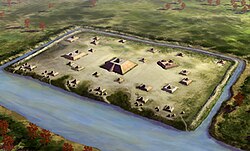 An illustration of what the Holly Bluff site may have looked like. Artist Herb Roe | |
| Location | Holly Bluff, Mississippi, Yazoo County, Mississippi, |
|---|---|
| Region | Yazoo County, Mississippi |
| Coordinates | 32°48′50.77″N 90°40′58.62″W / 32.8141028°N 90.6829500°W |
| History | |
| Founded | 800 |
| Abandoned | 1500 |
| Periods | Plaquemine Mississippian |
| Cultures | Plaquemine culture |
| Site notes | |
| Excavation dates | 1908, 1928, 1936, 1949, 1958-1960 |
| Archaeologists | Clarence Bloomfield Moore, Philip Phillips, James A. Ford, Paul Gebhard, Nick Zeigler in |
| Architecture | |
| Architectural styles | platform mound |
| Architectural details | Number of temples: 25 |
Holly Bluff site | |
| NRHP reference No. | 66000412 |
| Significant dates | |
| Added to NRHP | October 15, 1966[1] |
| Designated NHL | July 19, 1964[2] |
| Responsible body: Private | |
The Holly Bluff site (22 YZ 557), sometimes known as the Lake George Site, and locally as "The Mound Place," is an archaeological site that is a type site for the Lake George phase of the prehistoric Plaquemine culture period of the area. The site is on the southern margin of the Mississippian cultural advance down the Mississippi River and on the northern edge of that of the Cole's Creek and Plaquemine cultures of the South."[2] The site was first excavated by Clarence Bloomfield Moore in 1908 and tested by Philip Phillips, Paul Gebhard and Nick Zeigler in 1949.
It was declared a National Historic Landmark in 1964.[2] The mounds are listed on the Mississippi Mound Trail.[3]
- ^ "National Register Information System". National Register of Historic Places. National Park Service. January 23, 2007.
- ^ a b c "Holly Bluff Site". National Historic Landmark summary listing. National Park Service. Archived from the original on June 5, 2011. Retrieved October 22, 2007.
- ^ "Mississippi Mound Trail". Mississippi Department of Archives and History. Archived from the original on July 9, 2021. Retrieved July 13, 2021.
